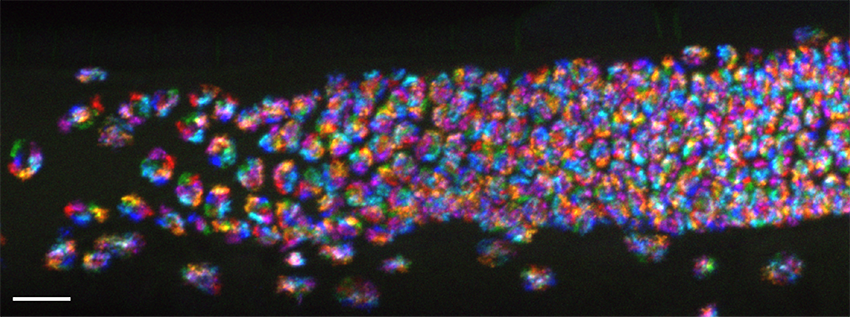
In the image above, worm DNA glows in tiny rainbow clusters under a fluorescent microscope.
Each sphere reveals the genetic material contained within the nucleus of a single cell in the common model organism Caenorhabditis elegans.
Each color illuminates one of the worm’s six chromosomes.
Researchers led by Scott Kennedy, the Philip and Aya Leder Professor of Genetics in the Blavatnik Institute at Harvard Medical School, achieved these striking results by expanding upon an established imaging method called FISH, short for fluorescence in situ hybridization.
Over the last few decades, FISH has allowed scientists to begin to understand how DNA is organized in three dimensions. Such studies provide greater insight into how this so-called genetic architecture affects normal and abnormal gene function, including which genes are turned on and off at given times.

Using a type of FISH called Oligopaints that was previously developed in the lab of HMS Professor of Genetics Ting Wu, the researchers created a collection of probes that enables scientists to study the 3D structure of the entire genome of C. elegans at all stages of the worm’s life cycle—from embryonic development to reproduction to aging—and at three different scales: whole chromosomes, three megabases (3 million DNA bases) and 500 kilobases (500,000 DNA bases).
In doing so, the tool, reported May 14 in eLife, promises to illuminate how genetic architecture affects and is affected by gene activity, cell specialization and other biological phenomena in different types of cells over developmental time. The results could deepen understanding of basic biology and disease, not only in C. elegans but in other organisms as well, including humans.
Kennedy was senior author of the study. Brandon Fields, a former graduate student in the Kennedy lab who is now at the Massachusetts Institute of Technology, and Son Nguyen, a former graduate student in the Wu lab who is now at the University of Pennsylvania’s Perelman School of Medicine, were co-first authors. Guy Nir, research fellow in genetics in the Wu lab, was also a coauthor.
The work was supported by the National Institutes of Health (grants 5DP1GM106412, R01HD091797, R01GM123289 and R01GM088289).



